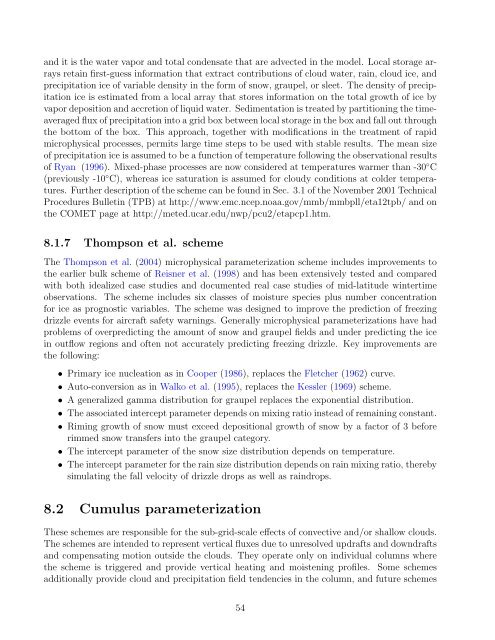Advanced Research WRF (ARW) Technical Note - MMM - University ...
Advanced Research WRF (ARW) Technical Note - MMM - University ...
Advanced Research WRF (ARW) Technical Note - MMM - University ...
You also want an ePaper? Increase the reach of your titles
YUMPU automatically turns print PDFs into web optimized ePapers that Google loves.
and it is the water vapor and total condensate that are advected in the model. Local storage arrays<br />
retain first-guess information that extract contributions of cloud water, rain, cloud ice, and<br />
precipitation ice of variable density in the form of snow, graupel, or sleet. The density of precipitation<br />
ice is estimated from a local array that stores information on the total growth of ice by<br />
vapor deposition and accretion of liquid water. Sedimentation is treated by partitioning the timeaveraged<br />
flux of precipitation into a grid box between local storage in the box and fall out through<br />
the bottom of the box. This approach, together with modifications in the treatment of rapid<br />
microphysical processes, permits large time steps to be used with stable results. The mean size<br />
of precipitation ice is assumed to be a function of temperature following the observational results<br />
of Ryan (1996). Mixed-phase processes are now considered at temperatures warmer than -30 ◦ C<br />
(previously -10 ◦ C), whereas ice saturation is assumed for cloudy conditions at colder temperatures.<br />
Further description of the scheme can be found in Sec. 3.1 of the November 2001 <strong>Technical</strong><br />
Procedures Bulletin (TPB) at http://www.emc.ncep.noaa.gov/mmb/mmbpll/eta12tpb/ and on<br />
the COMET page at http://meted.ucar.edu/nwp/pcu2/etapcp1.htm.<br />
8.1.7 Thompson et al. scheme<br />
The Thompson et al. (2004) microphysical parameterization scheme includes improvements to<br />
the earlier bulk scheme of Reisner et al. (1998) and has been extensively tested and compared<br />
with both idealized case studies and documented real case studies of mid-latitude wintertime<br />
observations. The scheme includes six classes of moisture species plus number concentration<br />
for ice as prognostic variables. The scheme was designed to improve the prediction of freezing<br />
drizzle events for aircraft safety warnings. Generally microphysical parameterizations have had<br />
problems of overpredicting the amount of snow and graupel fields and under predicting the ice<br />
in outflow regions and often not accurately predicting freezing drizzle. Key improvements are<br />
the following:<br />
• Primary ice nucleation as in Cooper (1986), replaces the Fletcher (1962) curve.<br />
• Auto-conversion as in Walko et al. (1995), replaces the Kessler (1969) scheme.<br />
• A generalized gamma distribution for graupel replaces the exponential distribution.<br />
• The associated intercept parameter depends on mixing ratio instead of remaining constant.<br />
• Riming growth of snow must exceed depositional growth of snow by a factor of 3 before<br />
rimmed snow transfers into the graupel category.<br />
• The intercept parameter of the snow size distribution depends on temperature.<br />
• The intercept parameter for the rain size distribution depends on rain mixing ratio, thereby<br />
simulating the fall velocity of drizzle drops as well as raindrops.<br />
8.2 Cumulus parameterization<br />
These schemes are responsible for the sub-grid-scale effects of convective and/or shallow clouds.<br />
The schemes are intended to represent vertical fluxes due to unresolved updrafts and downdrafts<br />
and compensating motion outside the clouds. They operate only on individual columns where<br />
the scheme is triggered and provide vertical heating and moistening profiles. Some schemes<br />
additionally provide cloud and precipitation field tendencies in the column, and future schemes<br />
54
















